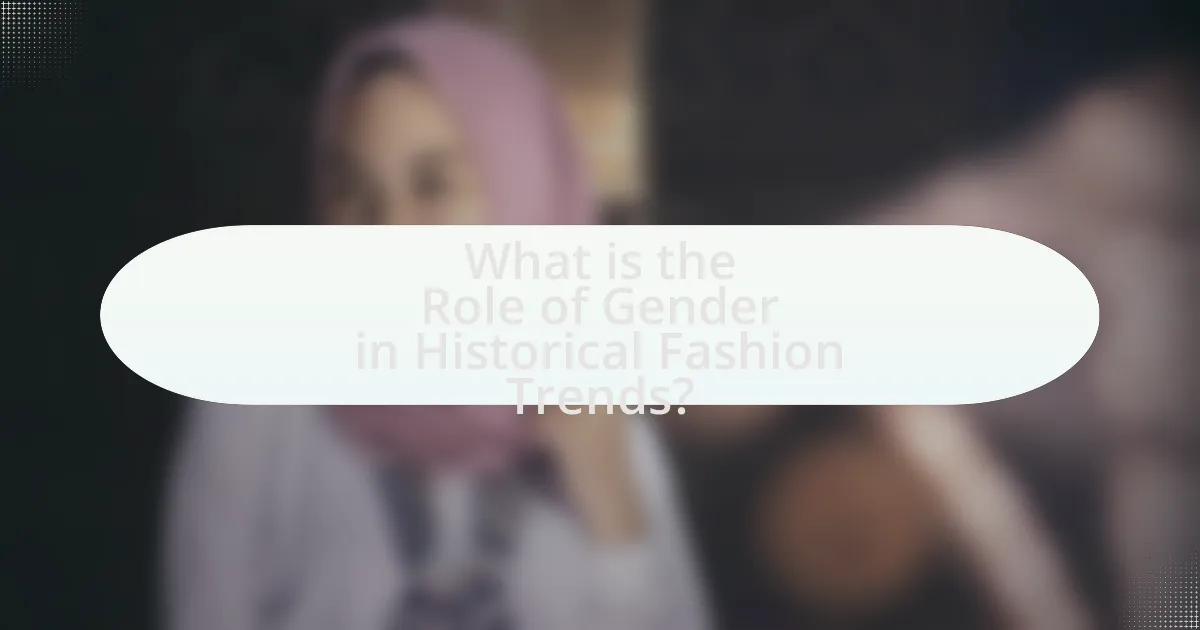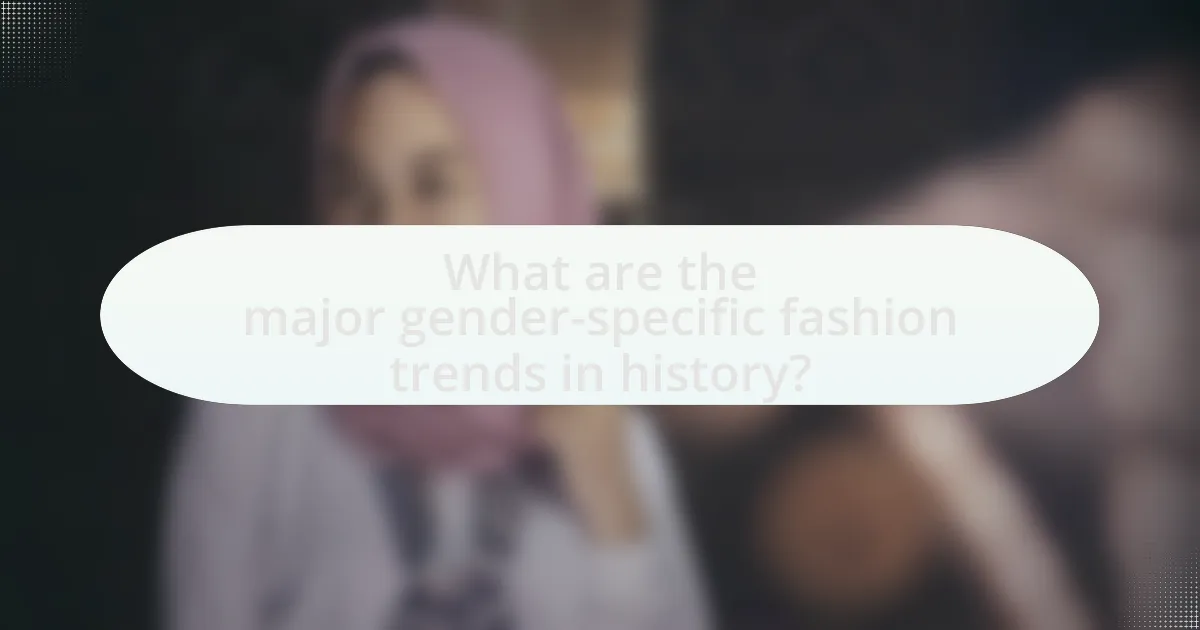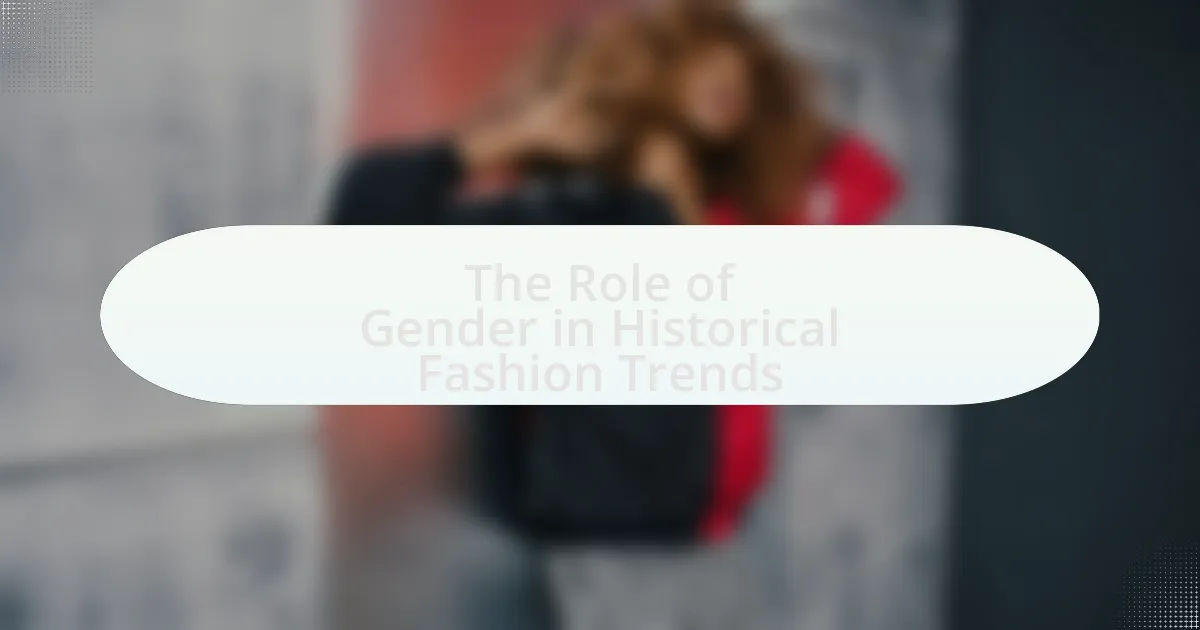The article examines the significant role of gender in shaping historical fashion trends, highlighting how clothing styles, materials, and societal expectations have evolved over time. It explores key historical periods, such as the Renaissance, Victorian Era, and the 20th century, illustrating how gender norms influenced fashion choices and reinforced societal roles. The discussion includes the impact of feminist movements on women’s fashion, the evolution of men’s attire in relation to masculinity, and contemporary trends that reflect historical gender constructs. Additionally, it addresses the importance of understanding these dynamics for future fashion choices and the ongoing dialogue about gender identity and expression in the fashion industry.

What is the Role of Gender in Historical Fashion Trends?
The role of gender in historical fashion trends is significant, as it shapes the styles, materials, and societal expectations associated with clothing. Throughout history, gender has dictated not only the types of garments worn but also the cultural meanings attached to them. For instance, during the Victorian era, women’s fashion emphasized modesty and femininity through corsets and long skirts, reflecting societal norms about women’s roles. Conversely, men’s fashion often showcased power and status, with tailored suits and accessories like top hats symbolizing authority. Historical records, such as fashion magazines and paintings, illustrate these gendered distinctions, highlighting how clothing has been used to reinforce or challenge gender roles across different periods.
How has gender influenced fashion throughout history?
Gender has significantly influenced fashion throughout history by dictating styles, materials, and societal norms associated with clothing. For instance, during the 18th century, European men wore elaborate garments, including powdered wigs and ornate fabrics, reflecting their social status, while women’s fashion emphasized femininity through corsets and voluminous skirts. The Industrial Revolution in the 19th century shifted these dynamics, as mass production made clothing more accessible, leading to the emergence of distinct gendered styles, such as the tailored suit for men and the hourglass silhouette for women. In the 20th century, movements for gender equality prompted shifts in fashion, with women adopting traditionally masculine styles, such as trousers and blazers, while men began to embrace more casual and expressive clothing. This evolution illustrates how gender roles and societal expectations have continuously shaped fashion trends, reflecting broader cultural changes.
What are the key historical periods to consider in this analysis?
The key historical periods to consider in the analysis of the role of gender in historical fashion trends include the Renaissance, the Victorian Era, and the 20th century. The Renaissance (14th to 17th centuries) marked a significant shift in gender expression through fashion, with elaborate garments reflecting social status and gender roles. The Victorian Era (1837-1901) emphasized strict gender norms, influencing women’s fashion with corsets and elaborate dresses that symbolized femininity. The 20th century introduced more radical changes, particularly during the 1920s with flapper styles that challenged traditional gender roles, and the feminist movements of the 1960s and 1970s that further transformed women’s clothing to reflect independence and equality. Each of these periods illustrates how fashion has been a medium for expressing and challenging gender identities.
How do societal norms shape gender-specific fashion trends?
Societal norms significantly shape gender-specific fashion trends by dictating acceptable behaviors, roles, and aesthetics for different genders. These norms influence the types of clothing deemed appropriate for men and women, often reinforcing traditional gender roles. For example, in the 19th century, women were expected to wear long dresses that emphasized femininity, while men wore tailored suits that conveyed authority and masculinity. This division is supported by historical evidence, such as the Victorian era’s strict dress codes, which mandated specific styles for each gender, reflecting societal expectations of modesty and propriety. Additionally, contemporary fashion trends continue to be influenced by societal norms, as seen in the rise of gender-neutral clothing lines that challenge traditional binaries, indicating a shift in societal perceptions of gender.
Why is understanding gender in fashion important?
Understanding gender in fashion is important because it influences design, marketing, and consumer behavior within the industry. Gender shapes the way clothing is created and perceived, impacting trends and societal norms. For instance, historical shifts in gender roles have led to significant changes in fashion, such as the adoption of trousers by women in the early 20th century, reflecting broader social movements for gender equality. This connection between gender and fashion underscores the necessity for designers and brands to consider gender identity and expression, as it directly affects their relevance and success in a diverse market.
What impact does gendered fashion have on identity and self-expression?
Gendered fashion significantly influences identity and self-expression by reinforcing societal norms and expectations related to gender roles. This impact is evident in how clothing choices often reflect and communicate an individual’s gender identity, shaping perceptions both internally and externally. For instance, studies show that individuals who conform to traditional gendered fashion may experience social acceptance, while those who challenge these norms often face stigma or discrimination. Historical examples, such as the Victorian era’s strict gender dress codes, illustrate how fashion has been used to delineate gender boundaries, affecting personal identity and societal roles. Thus, gendered fashion serves as a powerful medium through which individuals navigate their identities and express themselves within the constraints of cultural expectations.
How does gender in fashion reflect broader cultural changes?
Gender in fashion reflects broader cultural changes by serving as a visual representation of societal norms, values, and shifts in gender roles. For instance, the rise of unisex clothing in the 1960s coincided with the feminist movement, challenging traditional gender binaries and promoting equality. Additionally, the increasing acceptance of identities in recent years has influenced fashion trends, leading to more fluid expressions of gender through clothing. Historical examples include the adoption of trousers by women during World War II, which symbolized their entry into the workforce and a redefinition of femininity. These shifts in fashion not only mirror cultural transformations but also actively contribute to the ongoing dialogue about gender identity and expression.

What are the major gender-specific fashion trends in history?
Major gender-specific fashion trends in history include the corset for women in the 19th century, which emphasized an hourglass figure, and the adoption of tailored suits for men in the early 20th century, symbolizing professionalism and masculinity. The corset, prevalent during the Victorian era, restricted women’s movement and was often associated with societal expectations of femininity. In contrast, men’s tailored suits became a staple in business attire, reflecting a shift towards modernity and the professionalization of male identity. These trends illustrate how fashion has historically reinforced gender roles and societal norms.
How did men’s fashion evolve in relation to gender roles?
Men’s fashion evolved significantly in relation to gender roles, reflecting societal changes and shifting perceptions of masculinity. In the 18th century, men wore elaborate clothing, including wigs and ornate fabrics, which indicated wealth and status, aligning with a more fluid understanding of gender expression. As the Industrial Revolution progressed in the 19th century, men’s fashion became more utilitarian and standardized, mirroring the rise of the middle class and a more rigid view of masculinity that emphasized practicality and strength.
By the 20th century, particularly post-World War II, men’s fashion began to incorporate elements of rebellion and individuality, influenced by cultural movements such as the Beat Generation and later, the counterculture of the 1960s. This shift allowed for greater experimentation with styles, challenging traditional gender norms. The late 20th and early 21st centuries saw a further blurring of gender lines in fashion, with designers like Jean-Paul Gaultier and brands like Gucci promoting androgynous styles, reflecting a broader acceptance of diverse gender identities and expressions.
These changes in men’s fashion illustrate how evolving gender roles have influenced clothing choices, moving from rigid definitions of masculinity to a more inclusive understanding that embraces individuality and self-expression.
What were the defining styles for men in different historical contexts?
Defining styles for men have varied significantly across historical contexts, reflecting cultural, social, and economic influences. In the 18th century, for example, men commonly wore elaborate garments such as frock coats, waistcoats, and breeches, often adorned with lace and embroidery, which signified wealth and status. The Industrial Revolution in the 19th century shifted men’s fashion towards more practical attire, with the introduction of the modern suit, characterized by tailored jackets and trousers, emphasizing a more streamlined silhouette that represented the emerging middle class.
In the early 20th century, styles evolved further with the adoption of the three-piece suit, which became a staple for formal occasions, while casual wear began to emerge with items like polo shirts and khakis. The 1960s and 1970s introduced bold patterns and colors, influenced by counterculture movements, with styles such as bell-bottoms and tie-dye shirts gaining popularity among younger generations. By the late 20th century, the rise of streetwear and casual fashion marked a significant departure from traditional styles, with brands like Nike and Adidas becoming symbols of youth culture.
These shifts in men’s fashion not only reflect changing aesthetics but also societal values, such as the move towards individualism and the blurring of gender norms in contemporary styles.
How did masculinity influence fashion choices over time?
Masculinity has significantly influenced fashion choices over time by dictating styles that reflect power, status, and societal norms. For instance, during the Renaissance, men wore elaborate garments with ruffles and lace, symbolizing wealth and sophistication, while the Industrial Revolution shifted fashion towards more practical and tailored clothing, emphasizing functionality and a more austere masculine ideal. In the 20th century, the emergence of the “suit” as a staple of male fashion represented authority and professionalism, further reinforcing traditional masculine values. Historical evidence shows that these shifts in fashion were often aligned with broader cultural changes, such as the rise of the feminist movement in the 1960s, which challenged conventional masculinity and led to more diverse expressions of male identity in fashion.
What were the key fashion trends for women throughout history?
Key fashion trends for women throughout history include the corset in the 19th century, flapper dresses in the 1920s, and the rise of casual wear in the late 20th century. The corset, popularized during the Victorian era, emphasized an hourglass figure and was a symbol of femininity and social status. In the 1920s, flapper dresses represented a shift towards more liberated styles, reflecting women’s newfound independence post-World War I, characterized by dropped waistlines and shorter hemlines. By the late 20th century, casual wear became dominant, influenced by the feminist movement and changing societal norms, leading to the popularity of jeans and comfortable clothing. These trends illustrate how women’s fashion has evolved in response to cultural, social, and political changes throughout history.
How did women’s fashion reflect their societal status and roles?
Women’s fashion historically reflected their societal status and roles through the use of materials, styles, and accessories that indicated wealth, class, and social expectations. For instance, during the Victorian era, upper-class women wore elaborate dresses made from luxurious fabrics like silk and adorned with intricate lace, signaling their affluence and adherence to societal norms of femininity and modesty. In contrast, working-class women typically wore simpler, more practical clothing made from durable fabrics, which highlighted their economic status and the necessity of functionality over fashion. Additionally, the corset, a staple of women’s fashion in various periods, symbolized the societal expectation of a narrow waist and an idealized feminine silhouette, reinforcing gender roles that emphasized beauty and restraint. Thus, women’s fashion served as a visual representation of their societal roles and status, with specific styles and materials acting as indicators of class and gender expectations throughout history.
What were the major shifts in women’s fashion during feminist movements?
Major shifts in women’s fashion during feminist movements included the rejection of restrictive clothing, the embrace of more practical attire, and the incorporation of androgynous styles. In the early 20th century, suffragettes advocated for functional clothing, leading to the decline of corsets and the rise of simpler silhouettes. The 1960s and 1970s saw the introduction of pants as a staple in women’s wardrobes, symbolizing liberation and equality. Additionally, the feminist movements of these decades promoted unisex fashion, challenging traditional gender norms and allowing women to express their identities beyond conventional femininity. These shifts were significant in reflecting and influencing societal attitudes towards gender roles and women’s rights.

How do contemporary fashion trends reflect historical gender roles?
Contemporary fashion trends reflect historical gender roles by often reinforcing traditional notions of masculinity and femininity through clothing choices. For instance, the resurgence of tailored suits for women mirrors the historical shift in gender roles during the women’s liberation movement of the 1960s and 1970s, where women began to adopt styles traditionally associated with men to assert their presence in the workforce. Additionally, the popularity of gender-neutral clothing lines today highlights a growing awareness and challenge to rigid gender norms, echoing earlier movements that sought to blur the lines between male and female attire, such as the flapper style of the 1920s. This evolution in fashion demonstrates how societal attitudes towards gender continue to influence clothing design and consumer preferences, reflecting both progress and the persistence of historical gender constructs.
What current trends are influenced by historical gender fashion?
Current trends influenced by historical gender fashion include the resurgence of gender-neutral clothing, the popularity of oversized silhouettes, and the incorporation of vintage styles into modern wardrobes. Gender-neutral clothing draws from the androgynous styles of the 1960s and 1970s, reflecting a shift towards inclusivity and breaking traditional gender norms. Oversized silhouettes, reminiscent of 1990s grunge fashion, emphasize comfort and self-expression, aligning with contemporary values of individuality. Additionally, the revival of vintage styles, such as high-waisted trousers and tailored blazers, showcases a cyclical nature of fashion where past trends are reinterpreted for today’s consumers. These trends demonstrate how historical gender fashion continues to shape modern aesthetics and cultural conversations around identity.
How are modern designers reinterpreting historical gendered styles?
Modern designers are reinterpreting historical gendered styles by blending traditional elements with contemporary aesthetics, creating gender-fluid and inclusive fashion. For instance, designers like Gucci and Balenciaga have incorporated silhouettes and fabrics historically associated with one gender into collections aimed at all genders, challenging the binary notions of clothing. This approach reflects a broader cultural shift towards inclusivity, as evidenced by the rise of unisex collections and the increasing visibility of non-binary models on runways. Additionally, the use of historical motifs, such as Victorian lace or 1970s tailoring, is reimagined in modern contexts, allowing for a dialogue between past and present styles that resonates with diverse audiences.
What role does gender fluidity play in today’s fashion landscape?
Gender fluidity plays a significant role in today’s fashion landscape by challenging traditional gender norms and promoting inclusivity. This shift is evident in the rise of unisex clothing lines and designers who embrace non-binary aesthetics, reflecting a broader societal acceptance of diverse gender identities. For instance, brands like Gucci and Balenciaga have incorporated gender-neutral collections, which cater to a wider audience and encourage self-expression beyond binary classifications. The increasing visibility of gender-fluid individuals in fashion campaigns further reinforces this trend, as seen with models like Jaden Smith and Indya Moore, who advocate for fluidity in personal style. This evolution in fashion not only influences consumer choices but also drives industry standards towards greater representation and acceptance of all gender identities.
What lessons can we learn from the historical role of gender in fashion?
The historical role of gender in fashion teaches us that clothing has been a significant marker of social identity and power dynamics. Throughout history, fashion has reflected and reinforced gender norms, such as the 19th-century corset symbolizing women’s societal constraints, while men’s fashion often emphasized authority and control through tailored suits. Additionally, the evolution of gendered clothing, such as the rise of unisex fashion in the late 20th century, illustrates a shift towards challenging traditional gender roles. This evolution highlights how fashion can serve as a medium for social change, as seen in movements like feminism, which have used clothing to express resistance against gender stereotypes.
How can understanding historical trends inform future fashion choices?
Understanding historical trends can inform future fashion choices by revealing patterns in consumer preferences and societal influences. For instance, the resurgence of 1990s fashion in recent years illustrates how nostalgia can drive contemporary styles, as seen in the popularity of oversized silhouettes and grunge aesthetics. Historical analysis shows that fashion often reflects cultural shifts; for example, the feminist movements of the 1960s and 1970s led to the adoption of more practical and unisex clothing, which continues to influence gender-neutral fashion today. By studying these trends, designers and brands can anticipate market demands and create collections that resonate with current values and aesthetics.
What are some best practices for embracing gender diversity in fashion today?
To embrace gender diversity in fashion today, brands should implement inclusive sizing, diverse representation in marketing, and gender-neutral designs. Inclusive sizing ensures that clothing fits a wide range of body types, promoting accessibility for all genders. Diverse representation in marketing campaigns reflects the varied identities within the gender spectrum, fostering a sense of belonging and acceptance. Gender-neutral designs challenge traditional norms, allowing individuals to express themselves freely without conforming to binary standards. These practices are supported by research indicating that brands embracing diversity see increased customer loyalty and market share, as consumers increasingly seek authenticity and inclusivity in their fashion choices.

Leave a Reply